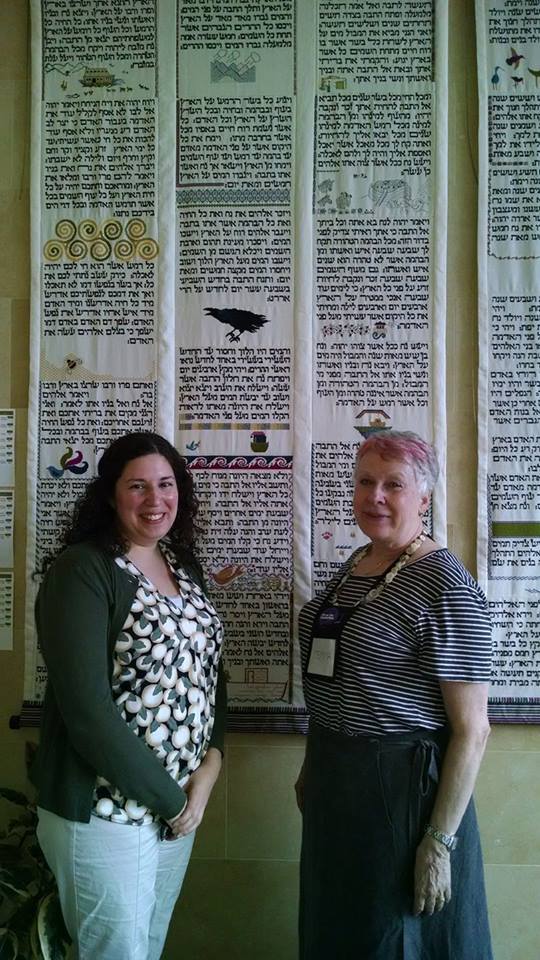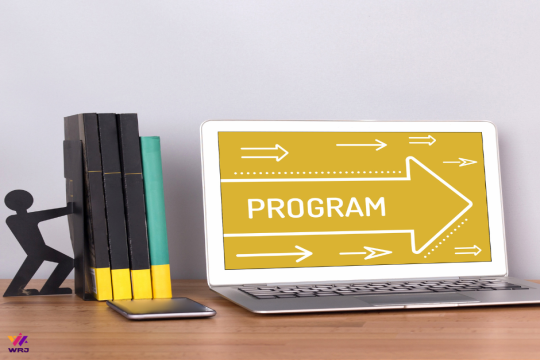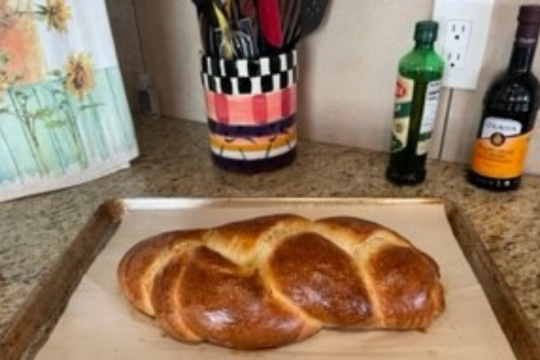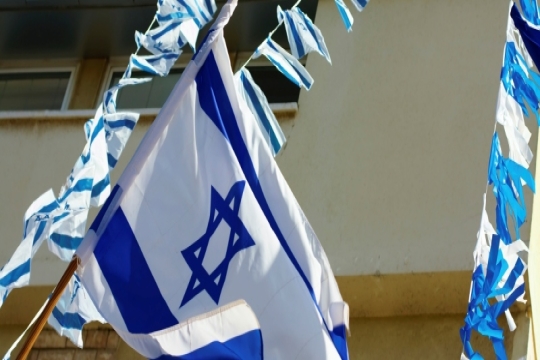
The following article was originally published in 2018, it has been updated in memory of Temma Gentles z”l.
When most people think of this week’s Torah portion, Parashat Noach, they think of the flood, the ark, and the animals. When I think of Parashat Noach, I think of cross stitch, Canada, and connection. During my first week of working at Women of Reform Judaism, I made plans to connect with the Vice President that I would be working with, Sara Charney (now WRJ President). Sara had just been introduced to a unique new project by her cousin, Temma Gentles z”l, who was serving as an artist-in-residence at Sara’s synagogue, Holy Blossom Temple. Temma, a renowned textile artist in Canada, created “Torah Stitch By Stitch,” an international project to engage with words of Torah through cross stitch. Temma described the project as “a unique and fascinating combination of big vision and small details, of slow traditional crafting and instantaneous technology, of professional calligraphic design and individual ‘folk’ creativity, and of study and passion.”
What an exciting project! I had never heard of or seen Jewish cross stitch before and was excited to sign up to participate. A few weeks later, I received my kit containing the cotton Aida cloth, black embroidery floss, a needle, and my four verses, Genesis 8:1-4, which was right in the middle of this parashah. I worked for several months on my panel and when it was completed, I sent it in.
Over the next few years, I received emails with information about the project. There would be pictures of completed panels, letters from participants, and updates about the number of sections assigned. In June of 2017 I received a very exciting email; the entire Book of Genesis was complete and would be displayed at a congregation in Toronto for the next 6 months. I reached out immediately to Sara because I needed to come to Toronto and see it in person. We made plans for my visit to take place just a few weeks later, at the beginning of July. Sara sent an email RSVP to set up our tour and heard back that Temma would be joining and was looking forward to meeting me.
When Sara and I arrived at the synagogue, I practically ran inside. I couldn’t wait to see the finished panels, and especially my contribution. We had some time to explore before the official tour started, so I was able to locate my panel immediately and take dozens of pictures of it, including pictures of me pointing at it and a picture of me and Temma next to it. The finished panels were beautiful. In addition to the text, some people added illuminations and borders to their sections.
When the tour started and our docent began telling us about the scope of the project including some of the stories of the stitchers, I got emotional. It was amazing to think about being part of something that connected over 1,500 people from 28 countries. Toward the end of Parashat Noach, we learn about all the generations that descended from Noah and how we are all part of this family. Participating in this project illuminated that for me and brought me closer to the Torah.
In 2019, the Textile Museum of Canada in Toronto exhibited the nearly completed project. Due to space constraints, they were not able to display the entire tapestry, but Genesis, Exodus, and half of Deuteronomy were displayed. Once again, I contacted Sara to visit her and see the exhibit. Temma met us there to give us a personalized tour. During the tour, I was able to meet other participants in the project and heard stories about the beautiful illuminations that were woven between the text on each panel. There was also a 15-minute documentary that shared details of the project and interviews with some of the participants from around the world. The exhibit was designed to make visitors feel like they were walking through the Torah, which was an unbelievable experience. I am forever grateful for contributing to this project, which meaningfully coincided with the start of my WRJ professional journey.
In my eyes, the project also represents accessibility to the Torah. Growing up, I was able to chant Torah at my bat mitzvah, however, I had many friends who were not allowed to do so. My grandmother was confirmed, but never had a bat mitzvah, and my mother had to wait until she was an adult before having her ceremony. Today, across North America, girls are not only chanting Torah at their bat mitzvahs, but they are doing so while wearing a tallit. When Temma Gentles z”l put out a request for participants in the Torah Stitch by Stitch project, she opened up and made the Torah accessible to people all over the world, and in many cases allowed them to engage with Torah for the very first time. May her memory be for a blessing.
Related Posts

Continuing to Educate and Empower People Together

My Challah-Making Experience

